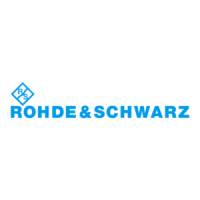Command reference
R&S
®
ZNA
1055User Manual 1178.6462.02 ─ 20
See also CALCulate<Chn>:TRANsform:DTFault:STARt and CALCulate<Chn>:
TRANsform:DTFault:STOP.
Suffix:
<Chn>
.
Channel number used to identify the active trace.
Parameters:
<Center>/<Span> Center/span value.
Default unit: m
Example:
:CALCulate1:TRANsform:DTFault:CENTer 2; SPAN 2
Defines the DtF distance window of the active trace of channel 1
via its center (2m) and span (2m).
Options: R&S ZNA-K2
Manual operation: See "Start Distance / Stop Distance" on page 763
CALCulate<Chn>:TRANsform:DTFault:PEAK:COUNt?
If the active trace of channel <Chn> is a Distance to Fault (DtF) trace and DtF limit
checking is enabled, this query returns the number of DtF limit violations of this trace.
Use CALCulate<Chn>:TRANsform:DTFault:PEAK:STATe to enable DtF limit
checking and CALCulate<Chn>:TRANsform:DTFault:PEAK:THReshold to set
the fault limit.
Suffix:
<Chn>
.
Channel number used to identify the active trace
Usage: Query only
Options: R&S ZNA-K2
Manual operation: See "Fault Table" on page 768
CALCulate<Chn>:TRANsform:DTFault:PEAK:DATA<FaultNo>
If the active trace of channel <Chn> is a Distance to Fault (DtF) trace and DtF limit
checking is enabled, this query returns the peak data of DtF limit violation <FaultNo>
<FaultNo> must be between 1 and CALCulate<Chn>:TRANsform:DTFault:PEAK:
COUNt?. The peak data are returned as value pair distance, response value.
Peaks are numbered according to their distance (fault no. 1 has the smallest distance).
Use CALCulate<Chn>:TRANsform:DTFault:PEAK:STATe to enable DtF limit
checking and CALCulate<Chn>:TRANsform:DTFault:PEAK:THReshold to set
the fault limit.
Suffix:
<Chn>
.
Channel number used to identify the active trace
<FaultNo> 1 ... CALCulate<Chn>:TRANsform:DTFault:PEAK:COUNt?
SCPI command reference

